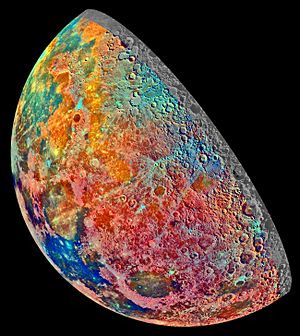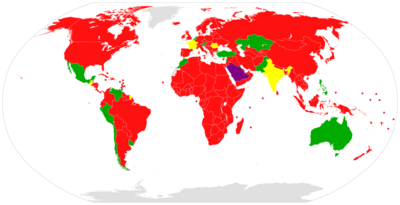Moon Treaty facts for kids
| Agreement Governing the Activities of States on the Moon and Other Celestial Bodies | |
|---|---|
| Signed | December 18, 1979 |
| Location | New York, USA |
| Effective | July 11, 1984 |
| Condition | 5 ratifications |
| Signatories | 11 |
| Parties | 17 (as of May 2024) |
| Depositary | Secretary-General of the United Nations |
| Languages | English, French, Russian, Spanish, Arabic and Chinese |
The Moon Treaty, also known as the Moon Agreement, is an international agreement. It was created to set rules for how countries should act in space. This includes the Moon and other space objects. The treaty aims to make sure all space activities follow international laws. These laws include the rules of the United Nations Charter.
However, big spacefaring countries like the United States, Russia, and China have not officially agreed to it. This means the treaty does not have much power in international law right now. As of May 2024, 17 countries are part of this treaty.
Contents
Why Was the Moon Treaty Created?
After the 1967 Outer Space Treaty was signed, space technology changed a lot. People realized new rules were needed for space exploration. The main goal of the 1979 Moon Treaty was to set clear rules. These rules would guide countries, groups, and people exploring space. It also aimed to manage any resources found in space. The treaty suggested creating an "international system" of rules. This system would explain how to use space resources fairly.
What Rules Does the Treaty Set?
The Moon Treaty suggests creating a set of rules. These rules would apply to the Moon and other space objects. This includes their orbits around planets or stars. The treaty has 21 different rules, called articles.
Sharing Space Resources
One important rule (Article 11) says the Moon should benefit everyone. No country can claim the Moon or its resources as their own. This means no country can own parts of the Moon. The treaty wants to stop conflicts over space. It says space resources should only be used for peaceful reasons.
Here are some key rules from the treaty:
- No Military Use: It bans any military activities on space objects. This includes testing weapons or building military bases. However, military people can do scientific research. They can also help with other peaceful activities (Article 3.4).
- Managing Resources: The treaty aims to create a system for using the Moon's natural resources. This system would ensure responsible use (Article 11.5).
- Protecting the Environment: Countries must not harm the environment of space objects. They also need to prevent accidental pollution. This includes protecting Earth from contamination (Article 7.1).
- Fair Sharing: Any benefits from lunar resources should be shared fairly. All countries that are part of the treaty should benefit (Article 11.7).
- No Ownership: Placing people or equipment on the Moon does not mean you own that land (Article 11).
- Freedom of Research: Everyone has the right to explore and research on the Moon. This should be done without unfair treatment (Article 6). Samples found during research should be shared. They should be available to all countries and scientists (Article 6.2).
- Special Scientific Areas: Any areas on the Moon that are very important for science should be protected. They would be called international scientific preserves (Article 7.3).
- Reporting Dangers: Countries must tell the United Nations and the public quickly. They need to report anything that could harm people. This includes any signs of extraterrestrial life (Article 5.3).
- Supervising Companies: Countries must make sure their private companies follow the rules. Companies working on the Moon must be supervised by their home country (Article 14).
- Sharing Information: Countries must tell the United Nations and the public about their space activities (Article 5).
The Moon Treaty repeats many rules from the 1967 Outer Space Treaty. But it adds two new ideas for space resources. First, it says space resources are the 'common heritage of mankind'. This means they belong to everyone. Second, it asks countries to create a system for organized mining. However, countries have not agreed on these two points.
How the Moon Treaty Came About
After the 1967 non-armament Outer Space Treaty was signed, the United Nations held a meeting. It was called UNISPACE in 1968. This meeting was about exploring space peacefully. It was the first of many meetings. The goal was to create international laws for using space resources.
After ten years of talks, the Moon Treaty was made in 1979. It was meant to be a set of rules. But some parts were not very clear. For example, Article 11.5 said that using the Moon's resources needed an international system. This system would set the right procedures. Many more meetings were held to define these rules. But countries could not agree. The main disagreements were about "Common Heritage of Mankind." This means whether space resources belong to everyone. They also disagreed on how each country could use the Moon's natural resources.
When Did the Treaty Start?
The treaty was finalized in 1979. It needed at least five countries to officially agree to it. Once five countries did, it became active for them in 1984. As of 2019, 18 countries are part of the treaty. Seven of these countries officially approved it. The others joined later. Four more countries have signed it but not yet approved it. Groups like the L5 Society worked against the United States signing the treaty.
Different Countries' Views
In 1980, the United States Senate discussed the Moon Treaty. Some people, like S. Neil Hosenball, supported it. He tried to explain how it was like mining laws on Earth. But he could not convince the committee. Others, like Leigh Ratiner from the L-5 Society, disagreed. They felt the treaty went against private businesses and property rights. Ratiner suggested a system for claiming rights to use resources on the Moon. He said it was about using resources, not owning the land itself.
In 2018, the United Nations Committee on the Peaceful Uses of Outer Space tried again. They held a big meeting to create rules for space. But they also failed to agree. S. Neil Hosenball, a key US negotiator, thought it was too early to set rules for space mining. He believed they should wait until it was clear if mining on the Moon was possible.
However, private companies want to invest in Moon missions. They say they need clear rules about making money from space resources. So, the US government passed a law in 2015. This law, called the Commercial Space Launch Competitiveness Act of 2015, made space mining legal for US companies. Other countries like Luxembourg, Japan, China, India, and Russia are making similar laws. Some experts say these new national laws do not fit with the Moon Treaty.
Why the Treaty Is Incomplete
A big debate about the Moon Treaty is about claiming resources. It's also about whether companies can mine for profit. Experts say the Moon Treaty does allow commercial mining. But it says this can only happen after an international system is set up. This system would have clear rules for mining. So, many people believe the Moon Treaty is not finished. It needs an "implementation agreement." This agreement would answer questions about how to get and use space resources.
What Is the Treaty's Legal Standing?
The treaty says no country can own any part of space. But because the treaty is not very clear, people understand it differently. This is a main reason why most countries have not signed it. The treaty suggests that using space resources needs an international system. But countries have not agreed on what these laws should be.
Some people say the treaty has not worked well. They think it might fail if not enough countries, especially those active in space, join it. Only two countries with their own space programs, France and India, have signed it. But they have not officially approved it.
In 2018, S. Neil Hosenball, a US negotiator, again suggested waiting. He thought rules for space mining should wait until it's clear if mining is possible. One lawyer said the treaty needs rules to stop one company from controlling all space resources. It also needs to avoid making space resources controlled by governments too much.
In 2020, the Artemis Accords were signed. These are new agreements about space exploration. They do not mention the Moon Treaty directly. But they offer a different way of thinking about space. When the Accords were signed, US President Donald Trump also issued an order. It said the US does not see space as a "global commons." This means the US does not think space belongs to everyone equally. He called the Moon Agreement "a failed attempt" to limit private businesses.
With Australia signing and approving both the Moon Treaty and the Artemis Accords, there has been a discussion if they can work together. Some suggest creating an Implementation Agreement for the Moon Treaty. This would help fix its unclear parts. It could also help it work better with other space laws. This might make more countries accept the Moon Treaty.
List of parties
| State | Signed | Deposited | Method |
|---|---|---|---|
| 19 Jan 2018 | Accession | ||
| 7 Jul 1986 | Accession | ||
| 21 May 1980 | 11 Jun 1984 | Ratification | |
| 29 Jun 2004 | Accession | ||
| 3 Jan 1980 | 12 Nov 1981 | Ratification | |
| 11 Jan 2001 | Accession | ||
| 28 Apr 2014 | Accession | ||
| 12 Apr 2006 | Accession | ||
| 11 Oct 1991 | Accession | ||
| 25 Jul 1980 | 21 Jan 1993 | Ratification | |
| 27 Jan 1981 | 17 Feb 1983 | Ratification | |
| 27 Feb 1986 | Accession | ||
| 23 Jun 1981 | 23 Nov 2005 | Ratification | |
| 23 Apr 1980 | 26 May 1981 | Ratification | |
| 29 Feb 2012 | Accession | ||
| 1 Jun 1981 | 9 Nov 1981 | Ratification | |
| 3 Nov 2016 | Accession |
List of signatories
| State | Signed |
|---|---|
| 29 Jan 1980 | |
| 20 Nov 1980 | |
| 18 Jan 1982 | |
| 17 Apr 1980 |
List of former parties
| State | Signed | Deposited | Method | Withdrawal notified | Withdrawal effective |
|---|---|---|---|---|---|
| 18 Jul 2012 | Accession | 5 Jan 2023 | 5 Jan 2024 |
See also
- Politics of outer space
- Space law
- Outer Space Treaty
- Treaty on Open Skies
- United Nations Convention on the Law of the Sea
- Artemis Accords
- Treaty on the Prohibition of Nuclear Weapons
- Rights of nature



